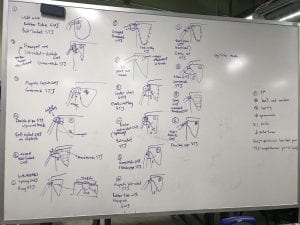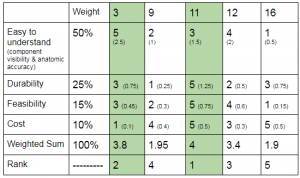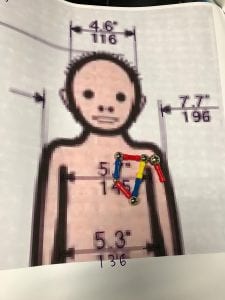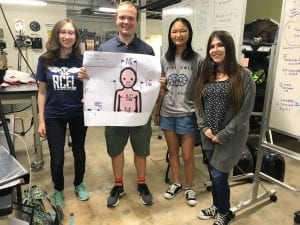Glory Hallelujah we finally made it to a design solution!! Caz’s estimate of 3 days for screening and scoring turned out to be light! we spent all of Friday going deeper and deeper down the rabbit hole of what mattered and what didn’t. The process was wildly frustrating and draining but the quality of our solutions was getting undeniably better. We decided to repeatedly screen down our design solutions until we had only a few ideas within each of our subcategories. Friday, Xiaoyao channeled her inner artist and drew out 16 different solutions we came up with. It may not look like much in those pictures but that represents more than a hundred man hours of work! I don’t think I have ever been happier to reach the end of a Friday!

I basically slept all weekend so Monday was not entirely unwelcome. Monday was screening and scoring. If you remember from my Tapir post, this is one of the more exhausting processes in  engineering design. We spent most of the morning screening our 8 mechanical solutions and our 8 elastic solutions. We had a little bit of trouble selecting a standard for our mechanical solutions. We initially chose a design that implemented a castor wheel to provide our degrees of motion as a standard. This ended up being a problem because its ease made it far too highly scoring to be a standard. We ended up having to redo that screening matrix after the results were clearly less than stellar. After that was sorted we worked on the elastic scores. This turned out to be much more challenging because the elastic solutions were much more difficult to visualize. They tended to work off of maintaining various tensions instead of established mechanical systems which meant it was hard to imagine how exactly they would move or the exact amount of material they would take. Ultimately we settled on advancing two elastic solutions and three mechanical solutions to our scoring matrix.
engineering design. We spent most of the morning screening our 8 mechanical solutions and our 8 elastic solutions. We had a little bit of trouble selecting a standard for our mechanical solutions. We initially chose a design that implemented a castor wheel to provide our degrees of motion as a standard. This ended up being a problem because its ease made it far too highly scoring to be a standard. We ended up having to redo that screening matrix after the results were clearly less than stellar. After that was sorted we worked on the elastic scores. This turned out to be much more challenging because the elastic solutions were much more difficult to visualize. They tended to work off of maintaining various tensions instead of established mechanical systems which meant it was hard to imagine how exactly they would move or the exact amount of material they would take. Ultimately we settled on advancing two elastic solutions and three mechanical solutions to our scoring matrix.
 Before scoring we established scales with which to rate all of our solutions. For example. if cost was something we were considering then we would say something receives a 1 if it costs less than 15 dollars, a 2 if it costs 15-20 dollars, and so on so forth. Unfortunately for us, 3 of the criteria we were using to judge are not distinct features. How would you go about objectively ranking how easy something is to understand. Our solution to this problem was to list attributes that we figured would make a solution easy to understand and then based the score on the number of the attributes a feature had. This turned out to be the same method used for feasibility and durability. Finally it was time to put it all together. We scored the final five ideas and settled on two solutions to advance to prototyping. Our solutions are the magnet capsule solution and the goose neck solution. Basically the magnet capsule mimics the function of the actual capsule found in the shoulder. We are hoping the similarity to actual anatomy as well as the strength control granted by magnets makes this solution viable and effective but we are unsure until the materials arrive to test with, The goose neck solution uses a device known as a goose neck to simulate the arm. A goose neck is a common household item you probably van find in any flexible lamp. It is a flexible metal tube that can easily be shaped but is also weight bearing. The pictures may make it easier to visualize.
Before scoring we established scales with which to rate all of our solutions. For example. if cost was something we were considering then we would say something receives a 1 if it costs less than 15 dollars, a 2 if it costs 15-20 dollars, and so on so forth. Unfortunately for us, 3 of the criteria we were using to judge are not distinct features. How would you go about objectively ranking how easy something is to understand. Our solution to this problem was to list attributes that we figured would make a solution easy to understand and then based the score on the number of the attributes a feature had. This turned out to be the same method used for feasibility and durability. Finally it was time to put it all together. We scored the final five ideas and settled on two solutions to advance to prototyping. Our solutions are the magnet capsule solution and the goose neck solution. Basically the magnet capsule mimics the function of the actual capsule found in the shoulder. We are hoping the similarity to actual anatomy as well as the strength control granted by magnets makes this solution viable and effective but we are unsure until the materials arrive to test with, The goose neck solution uses a device known as a goose neck to simulate the arm. A goose neck is a common household item you probably van find in any flexible lamp. It is a flexible metal tube that can easily be shaped but is also weight bearing. The pictures may make it easier to visualize.
Tuesday was presentations. This meant we spent all morning converting this summers work into a 15 minute power point to deliver to faculty and clients. Can’t Brachius finished with about an hour left in the morning prep time so we managed to get a couple run troughs in before the time came. I personally was delivering the portion surrounding screening and scoring. It turned out to be a better part than I thought it would be because there were a couple of anomalies in our screening and scoring that warranted explaining such as a decision to combine two of the solutions mid screening. Shout out to Anna for killing the hook and intro! Ultimately I thought it went well and Caz and Sammi were able to give us helpful feedback on what we can do better in the future. Fortunately we have another one coming up at the end of the summer so I am hoping for the chance to improve!
After presentations we ordered some starting material to work on our medium fidelity prototypes. Unfortunately the fourth of July is delaying shipping a bit. I  am hoping to see our materials by. next Monday. Wednesday was off for the fourth. There was a SEED cookout however I had to pull out at the last minute thanks to an untimely flooding of my garage where I was storing some peoples stuff for the summer. Thursday simply brought some prototyping and getting a scale image of a baby. We had a realization that an infant scapula is truly tiny. To put this in perspective, a babies scapula is not that much larger than a computer mouse. We determined it to be about 5X7 cm. Prototyping may prove challenging. In the meantime we scaled an image of a baby from the book The Measure of Man and Woman and brought it up to sclale in Adobe Illustrator. We printed it on the poster printer in the OEDK and it is truly terrifying. To end the morning we attempted low fidelity prototyping with mixed success. It was rather hard to demonstrate much more than basic concepts with the available material. We ended the day with a laser cutting workshop taught by our very own Sammi. For now we are waiting for material and I am looking forward to the next three weeks of prototyping!
am hoping to see our materials by. next Monday. Wednesday was off for the fourth. There was a SEED cookout however I had to pull out at the last minute thanks to an untimely flooding of my garage where I was storing some peoples stuff for the summer. Thursday simply brought some prototyping and getting a scale image of a baby. We had a realization that an infant scapula is truly tiny. To put this in perspective, a babies scapula is not that much larger than a computer mouse. We determined it to be about 5X7 cm. Prototyping may prove challenging. In the meantime we scaled an image of a baby from the book The Measure of Man and Woman and brought it up to sclale in Adobe Illustrator. We printed it on the poster printer in the OEDK and it is truly terrifying. To end the morning we attempted low fidelity prototyping with mixed success. It was rather hard to demonstrate much more than basic concepts with the available material. We ended the day with a laser cutting workshop taught by our very own Sammi. For now we are waiting for material and I am looking forward to the next three weeks of prototyping!



This seems to be a thorough report, but I am sorry Harrell and I couldn’t hear your presentation.
This seems to be a very thorough report that compensates for the fact that Harrell and I were unable to hear your oral presentation.
Carolyn Huff
July 6, 2018 at 3:20 am | Permalink
This seems to be a very thorough report that compensates for the fact that Harrell and I were unable to hear your oral presentation.